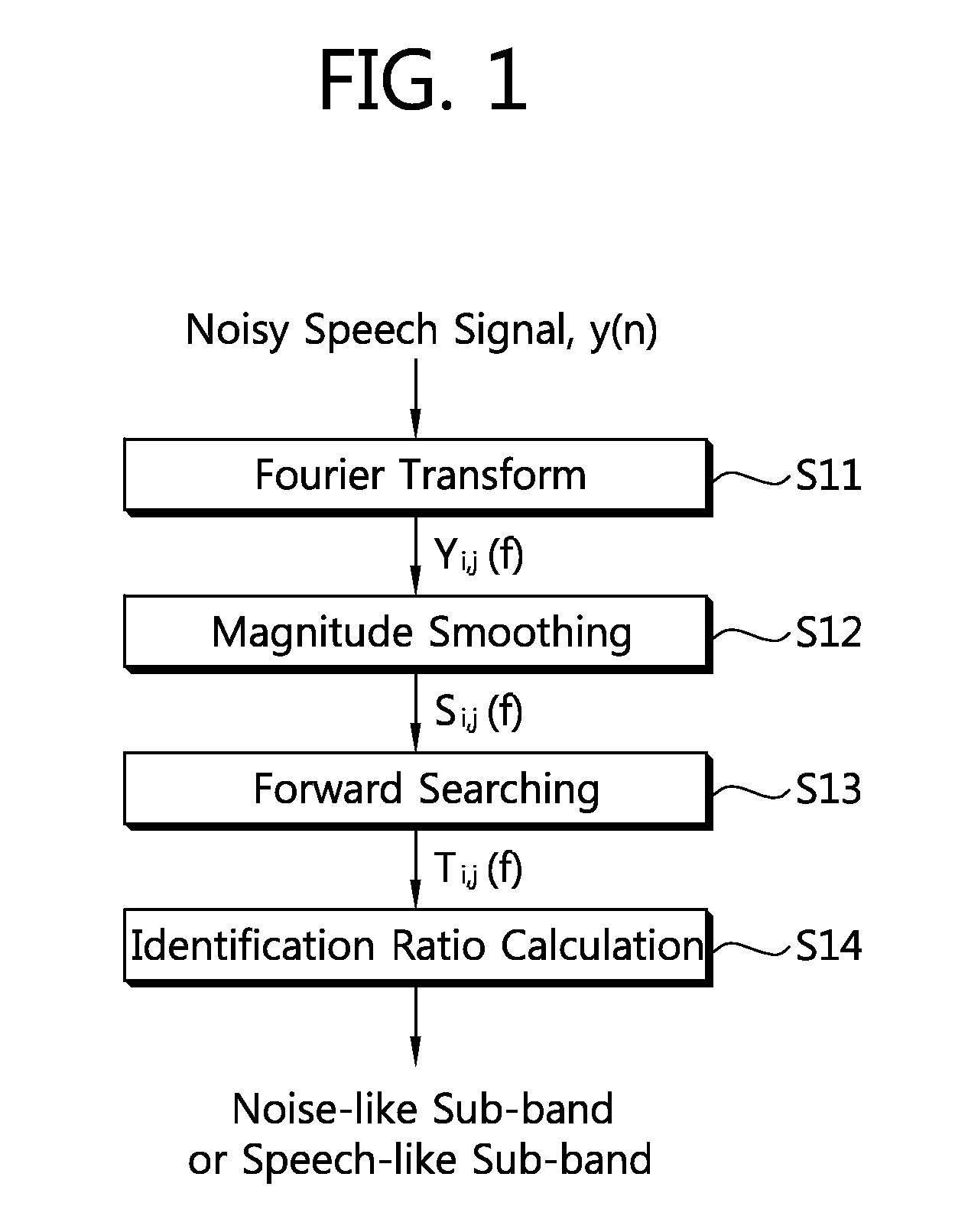Method for processing noisy speech signal, apparatus for same and computer-readable recording medium
- Summary
- Abstract
- Description
- Claims
- Application Information
AI Technical Summary
Benefits of technology
Problems solved by technology
Method used
Image
Examples
first embodiment
[0080]FIG. 1 is a flowchart of a noise state determination method of an input noisy speech signal y(n), as a method of processing a noisy speech signal, according to a first embodiment of the present invention.
[0081]Referring to FIG. 1, the noise state determination method according to the first embodiment of the present invention includes performing Fourier transformation on the input noisy speech signal y(n) (operation S11), performing magnitude smoothing (operation S12), performing forward searching (operation S13), and calculating an identification ratio (operation S14). Each operation of the noise state determination method will now be described in more detail.
[0082]Initially, the Fourier transformation is performed on the input noisy speech signal y(n) (operation S11). The Fourier transformation is continuously performed on short-time signals of the input noisy speech signal y(n) such that the input noisy speech signal y(n) may be approximated into a Fourier spectrum (FS) Yi(f...
second embodiment
[0137]FIG. 6 is a flowchart of a noise estimation method of an input noisy speech signal y(n), as a method of processing a noisy speech signal, according to a second embodiment of the present invention.
[0138]Referring to FIG. 6, the noise estimation method according to the second embodiment of the present invention includes performing Fourier transformation on the input noisy speech signal y(n) (operation S21), performing magnitude smoothing (operation S22), performing forward searching (operation S23), and performing adaptive noise estimation (operation S24). Here, operations S11 through S13 illustrated in FIG. 1 may be performed as operations S21 through S23. Thus, repeated descriptions may be omitted here.
[0139]Initially, the Fourier transformation is performed on the input noisy speech signal y(n) (operation S21). As a result of performing the Fourier transformation, the input noisy speech signal y(n) may be approximated into an FS Yi,j(f). Then, the magnitude smoothing is perfo...
third embodiment
[0160]FIG. 8 is a flowchart of a sound quality improvement method of an input noisy speech signal y(n), as a method of processing a noisy speech signal, according to a third embodiment of the present invention.
[0161]Referring to FIG. 8, the sound quality improvement method according to the third embodiment of the present invention includes performing Fourier transformation on the input noisy speech signal y(n) (operation S31), performing magnitude smoothing (operation S32), performing forward searching (operation S33), performing adaptive noise estimation (operation S34), measuring a relative magnitude difference (RMD) (operation S35), calculating a modified overweighting gain function with a non-linear structure (operation S36), and performing modified spectral subtraction (SS) (operation S37).
[0162]Here, operations S21 through S24 illustrated in FIG. 6 may be performed as operations S31 through S34. Thus, repeated descriptions may be omitted here. Since one of a plurality of chara...
PUM
 Login to view more
Login to view more Abstract
Description
Claims
Application Information
 Login to view more
Login to view more - R&D Engineer
- R&D Manager
- IP Professional
- Industry Leading Data Capabilities
- Powerful AI technology
- Patent DNA Extraction
Browse by: Latest US Patents, China's latest patents, Technical Efficacy Thesaurus, Application Domain, Technology Topic.
© 2024 PatSnap. All rights reserved.Legal|Privacy policy|Modern Slavery Act Transparency Statement|Sitemap



